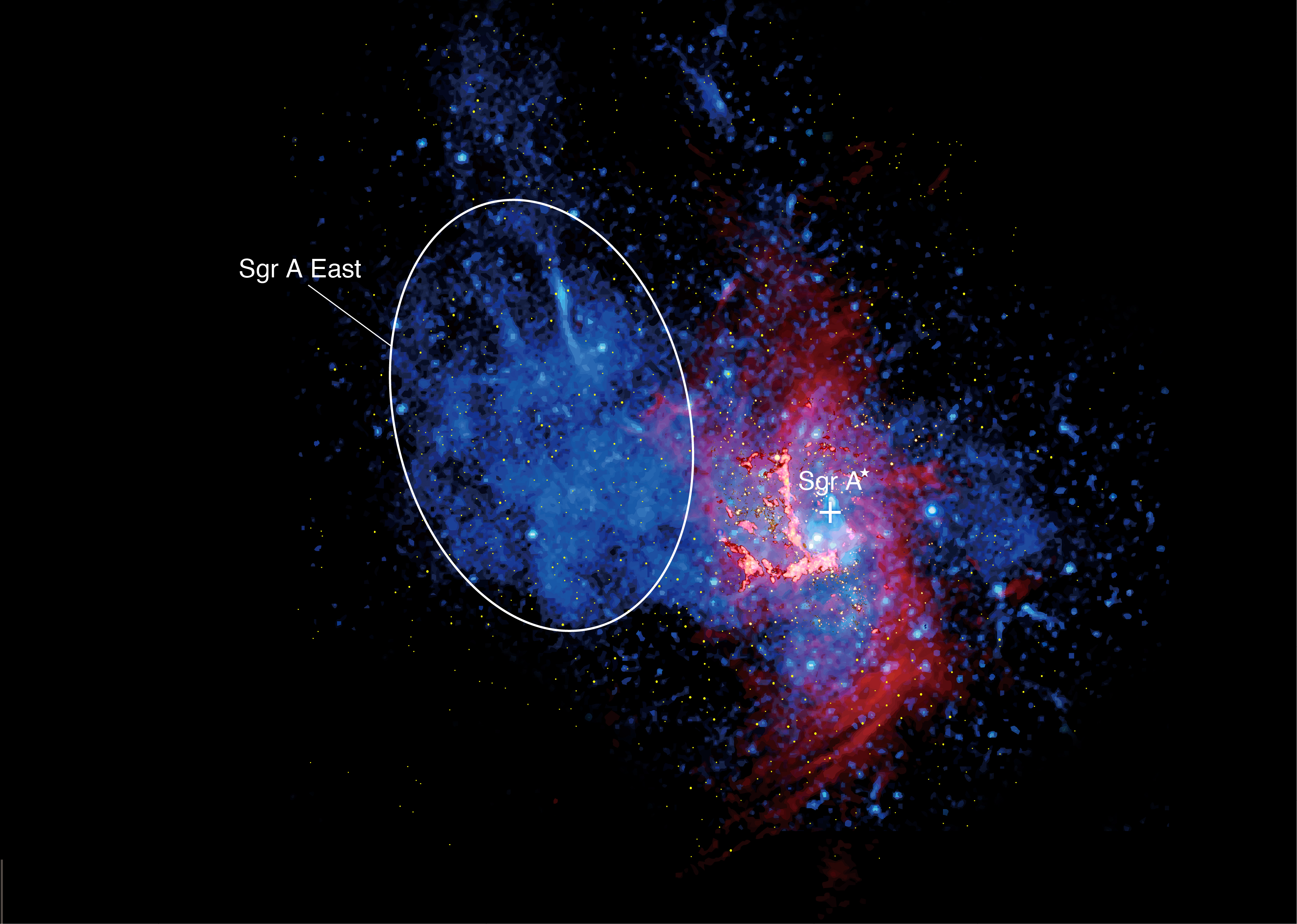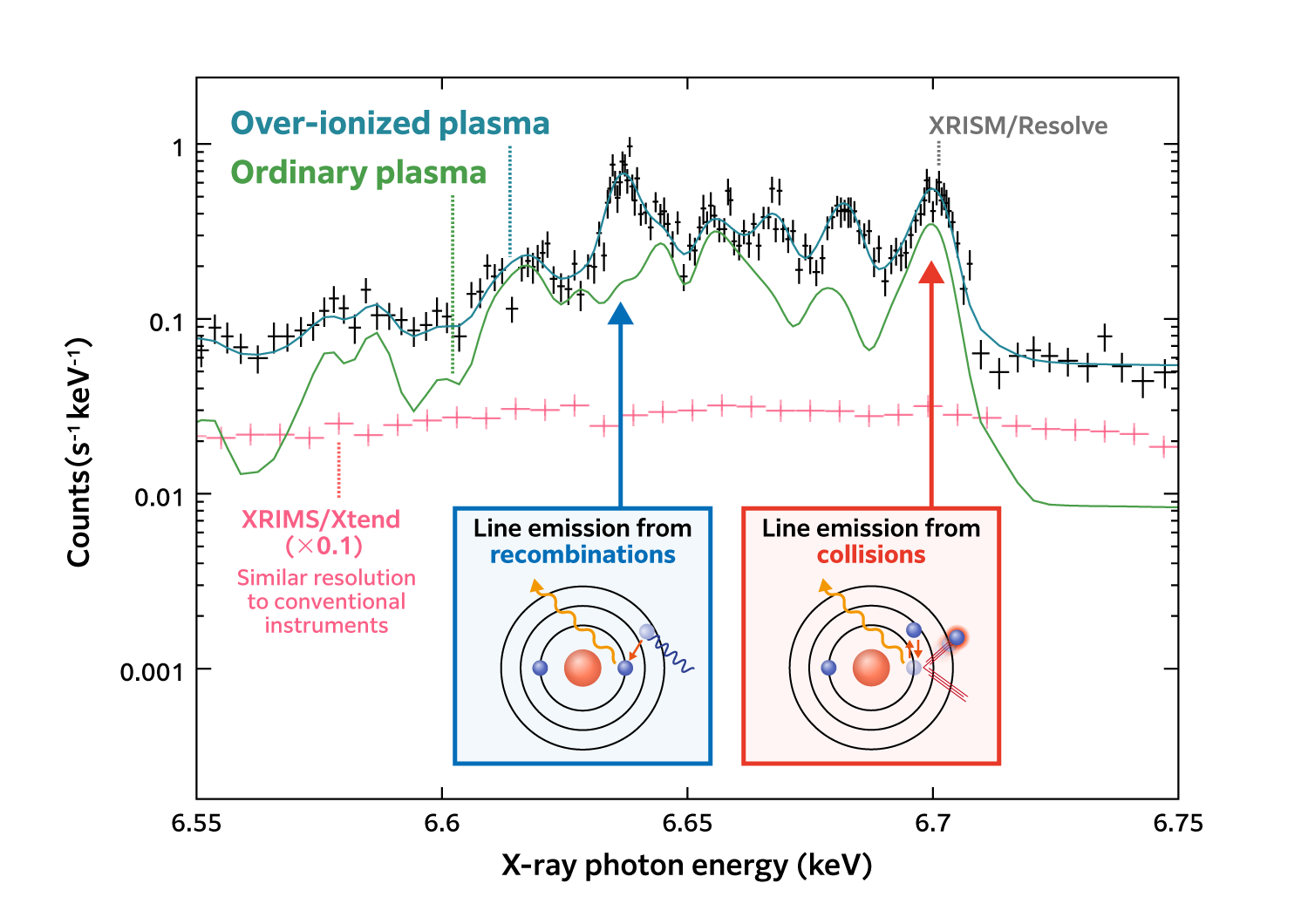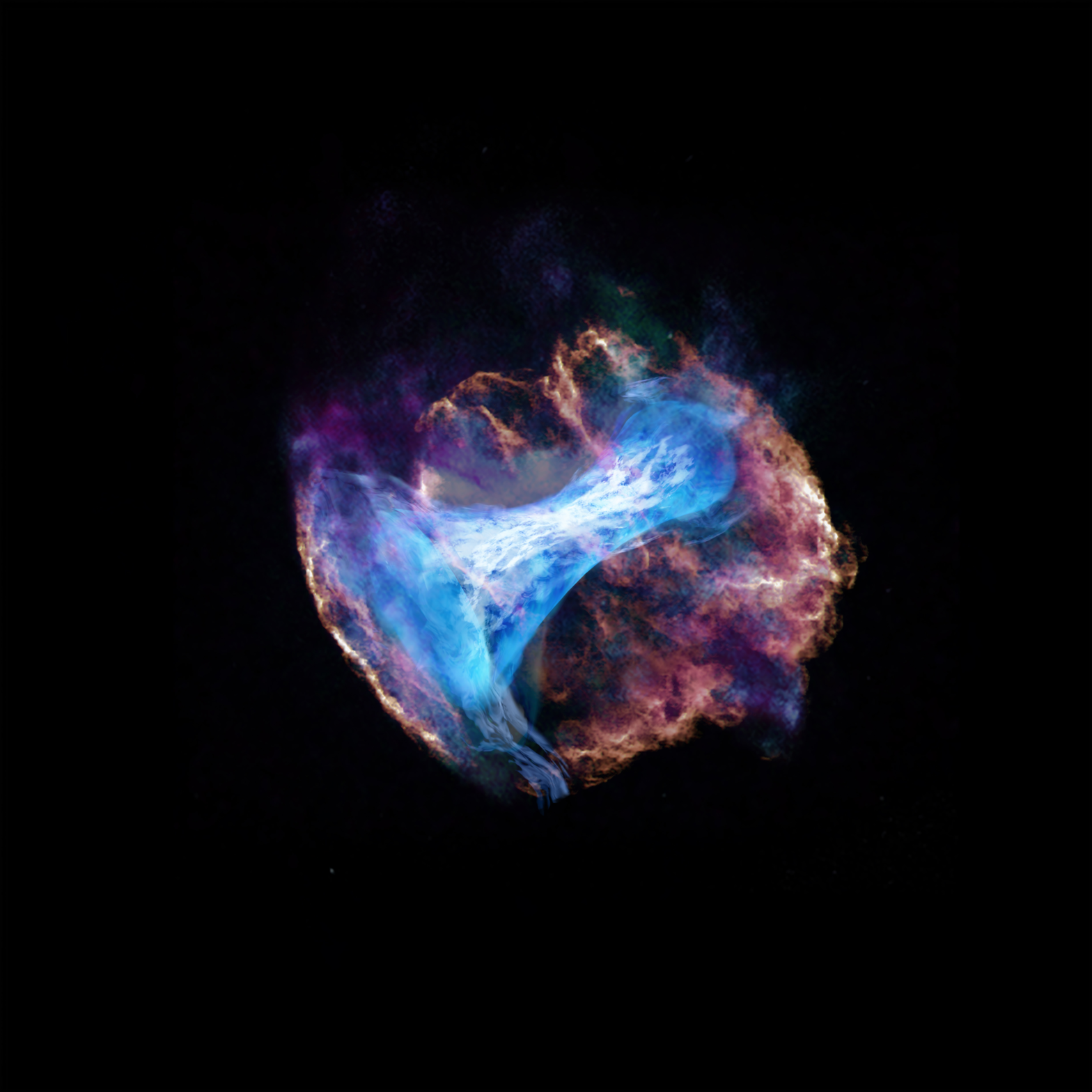A supernova explosion, the massive explosion that marks the final stage of a star’s life, generates shock waves traveling at thousands of kilometers per second in interstellar space. These shock waves transform the interstellar gas and ejected material into hot plasma, consisting of positively charged ions that are atoms which have been stripped of one or more electrons, and the stripped free electrons. This is known as a supernova remnant. “Sagittarius A East” is a supernova remnant located near the center of our Galaxy, notable for its close proximity—just a few light years—to the supermassive black hole, “Sagittarius A*”.
Using the X-ray Imaging and Spectroscopy Mission (XRISM), we conducted observations and precisely measured the state of the iron ions in the hot plasma. These results confirmed the presence of over-ionized iron ions, a phenomenon in which the atoms of iron have been stripped of more electrons than expected, suggesting a much hotter temperature than that measured from free electrons in the plasma.
This was previously suggested by past studies using the X-ray Astronomy Satellite “Suzaku”. The ionization degree (i.e., how many electrons have been lost) of the iron atoms corresponds to a temperature exceeding 50 million degrees Celsius, whereas the temperature of free electrons is around a much cooler 19 million degrees Celsius. Usually, the hottest free electrons with the highest energies collide with heavy elements such as iron, gradually stripping away their electron shells so that the atoms become steadily more ionized. In this case, the temperature based on the degree of ionization of the elements should be less than the average temperature of the free electrons. Thus, in our case, the temperature relationship is reversed.
This unusual situation indicates that the bound electrons of iron atoms were rapidly stripped away in the past. One possible explanation is X-ray bursts of the nearby supermassive black hole, Sagittarius A*, which may have occurred thousands of years ago, previously ionizing the elements in the supernova remnant.

Massive stars end their lives in a cataclysmic explosion known as a supernova, generating shock waves that travel through interstellar space at thousands of kilometers per second. These shock waves heat interstellar gas and ejected material, stripping the atoms of electrons to transforming the gas into a high-temperature plasma of positively charged ions and electrons. After high-energy free electrons*1 are produced, they collide with heavy elements, gradually stripping away (ionizing) their electron shells over tens of thousands of years. However, it is known that the plasma in some supernova remnants exhibits “over-ionized” ions, where the ionization degree suggests a temperature higher than that of the free electrons. This indicates that these remnants have undergone some unique evolutionary processes. To understand the exact physical mechanisms at play, a more precise understanding of the plasma state in these celestial objects is essential.
“Sagittarius A East” is a supernova remnant located near the center of our Galaxy, notable for its close proximity—just a few light-years—to the supermassive black hole at the galactic center, “Sagittarius A*” (Figure 1). Using the X-ray Imaging and Spectroscopy Mission (XRISM), we conducted observations and precisely measured the quantum states*2 of iron ions in the ejected material from the explosion.

XRISM can observe the intensity of X-rays at different wavelengths emitted by the plasma. This is known as spectroscopy. The observed wavelengths depend on the type of ion present, and the number and state of the electrons still bound to that ion. XRISM observed the emission from “helium-like” iron ions with only two remaining bound electrons (similar to an atoms of helium), and for the first time, it was possible to distinguish between the emission line caused by free-electron collisions, which is common in ordinary supernova remnant, and another emission line caused by free-electron re-combinations, which is characteristic of over-ionized iron ions (Figure 2). In the first case, a bound electron in a helium-like iron ion is once excited to a higher-energy state and de-excite to the ground state, while in the second case, a hydrogen-like iron ion (with only one remaining bound electron) gains a second electron to become a helium-like iron ion (Figure 2). These two options produce slightly different emission energies, which were detected by XRISM. Differentiating between these two cases also allows a precise measurement of the number ratio of helium-like to hydrogen-like iron ions, which determines the ionization degree.

The ionization degree corresponds to a temperature of approximately 54 million degrees Celsius, significantly exceeding the free-electron temperature of about 19 million degrees Celsius. This finding confirms and strengthens previous research conducted with the X-ray Astronomy Satellite “Suzaku”, which found features suggesting the over-ionization. This remarkable discrepancy between the ionization degree and free-electron temperature can be understood as “a chick (atomic nucleus) emerging from its egg (electron shell) even though the parent bird (free electrons) has not warmed it”. This unusual phenomenon indicates that a rapid electron-stripping event must have occurred in the past (Figure 3).
One possible cause is a powerful X-ray flare from the nearby supermassive black hole, Sagittarius A*, which may have occurred thousands of years ago. If this is the case, Sagittarius A East serves as a valuable “archaeological record” preserving the historical activity of the supermassive black hole.
This study has established that the supernova remnant Sagittarius A East, located in the central region of the galaxy, is in an unusual plasma state. The valuable data obtained by measuring the quantum states of a supernova remnant that has undergone a unique evolutionary process provide new insights into the activity of the supermassive black hole and the behavior of the progenitor star just before the supernova explosion. Beyond its scientific importance, this research also highlights the power of high-precision plasma diagnostics for extended X-ray sources, a capability made possible for the first time by XRISM. Future observations with XRISM and upcoming missions will contribute to a systematic understanding of supernova remnants that have experienced special evolutionary pathways, significantly advancing our knowledge of stellar evolution. This achievement serves as an initial step in establishing methodologies for such studies.
Glossary
- *1 Free electron: An electron that can move freely without being bound to atomic nuclei.
- *2 Quantum state: The state of an atom determined by physical quantities such as the number of electrons bound to the atom, their energy levels, and spin.
Paper
- Journal: Publication of the Astronomical Society of Japan Letters
- Title: Overionized plasma in the supernova remnant Sagittarius A East anchored by XRISM observations
- DOI: https://doi.org/10.1093/pasj/psae111
- Publication date: 26 December, 2024
- Authors: XRISM Collaboration




